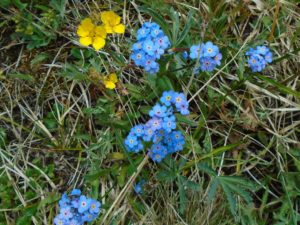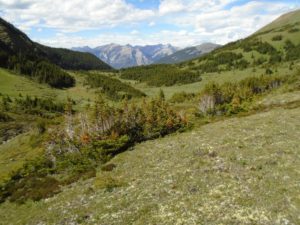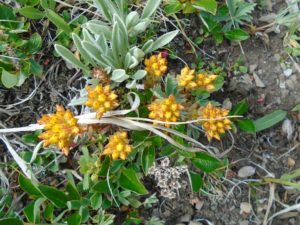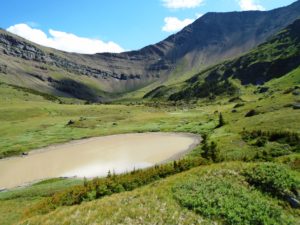When I did the Centennial Ridge hike a few years ago, I looked down from the top of Mt Allan into the valley below and thought that some day I’d like to come back and explore it.
The valley “hangs” between the towering ridges of Mt Collembola and Mt Allan and was in full bloom, but I’m undecided whether I was there early or late to see the best variety of wild flowers. I imagine some are finished blooming, while late-season varieties are yet to show.
The valley is also home to the “Jubilee tarns,” a series of muddy ponds which are not anything to write home about. Don’t go there with the tarns as your objective or you’ll be disappointed. If you’re looking for peace and solitude in a spectacular surrounding, this could be the place.
From the trailhead near Dead Man’s Flats, it’s a 7.5K hike with 710 metres net elevation to the valley. The valley is not flat by any means. I hiked through the valley for 1K, up and down a few grassy hills, gaining another 80 metres of net elevation to the top of the highest hill. From this viewpoint I could look down and see two of the muddy tarns.
From Gillean Daffern’s Kananaskis Trail Guide(3rd edition, vol 1), she writes:
“From the lip of the cirque a faint trail follows the right bank of the creek through fields of dwarf willow and Delphineums into the hanging valley between Collembola and Allan. Higher yet, the inner cirque is a labyrinth of small grassy hills and muddy ponds, the farthest one, tucked under Mt Allan, graced with the name Queen’s tarn. As a destination Jubilee Tarns are not worth the effort of the long walk in, but the valley is lovely, bounded by grassy slopes and seven-star flower gardens.”
Far off in the distance I saw three hikers on the saddle between the two mountains, and also spotted four hikers coming down from Centennial Ridge.





The yellow flower is a Stonecrop (Sedum) the fleshy stems and leaves are partially hidden by the foliage of other plants.
The red flower in photo #3 is also a Sedum, Ledge Stonecrop (or Roseroot).
The blue flowers in photo #2 appear to be Manyflower Stickseed (Hackelia floibunda), rather than Forgetmenots.
Thanks for the correction, Alf. I’m not even sure if the flowers in the top photo are Buttercups. My flower book shows a lot of yellow flowers that look similar.
From the leaves associated with the yellow flowers, I believe those are Varileaf Cinquefoil.
In looking up ‘sedum’ I see that my wife has a couple succulents of this genus in the garden.
Flower: yellow umbrella plant?
Beautiful valley that I had not heard of.
Thanks Bob.